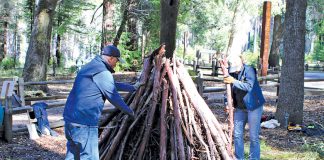1. Financial Planning is budgeting to allocate money that finances dreams.
At age 20, Sam simply cooked the finest barbecue cuisine for Sequoia weddings and Roaring Camp cookoffs, savoring each bite, then experimenting. Our culinary hero dreamt of becoming a Michelin star chef who ran his own restaurant. He also wanted a house, a family and a healthy retirement. How can buckets of budgeting help this risk-taker realize culinary dreams?
Creativity and hard work gave him $80,000 net income, so he bought two vans for $40,000 at 10%. Then food regulators slammed him for cooking outside commercial kitchens and he used credit cards at 30% interest to meet licensing requirements, including leased kitchen space and tenting. He then got hit by $18,000 of income and Social Security taxes as his tax preparer explained $4,500 estimated quarterly taxes. Business auto payments were $700 monthly for five years and $500 for credit cards.
Bankruptcy or adverse judgements would probably destroy his dream and he would not wallow in debt. He regretted overspending in good times and borrowing for legally predictable emergencies. To maintain a good FICO score (over 670 and slightly above average), Sam needed timely payments, low credit card usage with high available credit, and mixed credit sources. Had he bought only one clunker van and kept 20% of income in an emergency bucket for six months’ living expenses, he could have accepted slower business growth.
2. Divide budgets into buckets, by percentages of income, and fund accordingly.
With $6,666 monthly income, Sam sold a van to throw 22% ($1,500) income into tax buckets and a 5% fun bucket. He had to pay back taxes and amortized auto debts of $1,200/month but could concentrate $2,000 into the credit card payoff bucket as he suffered humble, guilty, living with tasty leftovers on a friend’s couch. Seemingly quick progress motivated him to pay small debts first. He then poured water from the credit card bucket into the van bucket and by age 23 was nearly debt free with lucrative business.
3. Pay off current expenses first (taxes, debt servicing), then smaller loans with higher interest.
Recognizing faulty management and improvised cooking, he moved to New York. “During culinary training,” boasts the Culinary Institute of America, “you’ll master ingredient sourcing, knife skills, presentation skills, taste testing and time management. You’ll also learn how to work with different ingredients, precision cooking and culinary creativity.” Pricey professional education (over $105,840) could make him a world class chef and restaurateur. Culinary work kept his student loans down to $80,000 at 6% and borrowing for average CA Michelin chef earnings of $135K/year made sense.
He returned to the SLV dreaming of enhancing the old Cosa Nostra restaurant and his renewed catering business shortly brought income and valuable connections. IRS and student loan buckets did slow his pace, but this entrepreneur now filled a restaurant bucket of diversified stock savings with 30% of earnings, roughly $2,500 a month. Partnership with a wealthy connoisseur lawyer and an award-winning local vintner gave him funds to purchase a restaurant and slowly improve it to Michelin Standards proven with regular inspections of restaurant “quality, consistency and creativity.” Personal buckets followed whereby he invested 5% into an emergency bucket, which later drained into 15% augmented earnings in a 401K, 15% into housing, 15% into a fun bucket that persistently rewarded more and 10% charity per ancient bucketing principles.
4. Borrow only for expensive indivisible needs, which avoid expensive consequences (e.g. ignorance, homelessness).
Others gloat on the social causes of failure, but this Horatio Alger’s rags-to-riches story still rings true with the caveat that specialized professional education creates wealth with investment prowess later multiplying affluence. Education and housing are the two best reasons to take on debt, with interest relatively low. It takes money to make money. Few today should take Sam’s debt risks and few are frugal enough to overcome debt. Business error, family or bad habits often interfere with goals that led Sam to restaurant ownership by 30. About 80% of new restaurants fail in five years and divorce or illness may be ruinous, so Sam lives forever by the bucket.
Robert Arne, EA, CFP, MS, of Carpe Diem Financial Life Planning, gives holistic financial advice as his client’s fee-only fiduciary. He serves mostly Santa Cruz dwellers. These articles are not personal financial, mortgage, tax or investment advice; consult appropriate professionals. Learn more at www.carpediem.financial.











